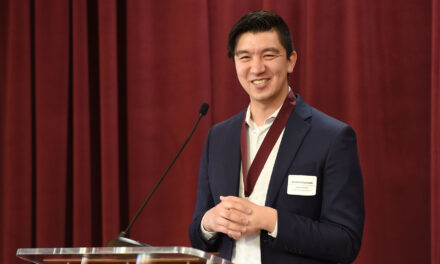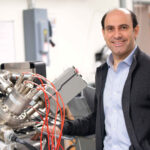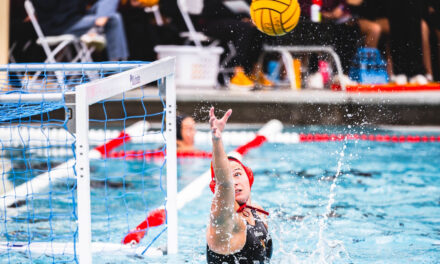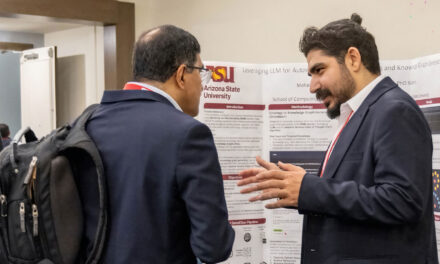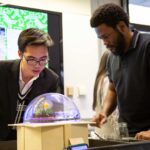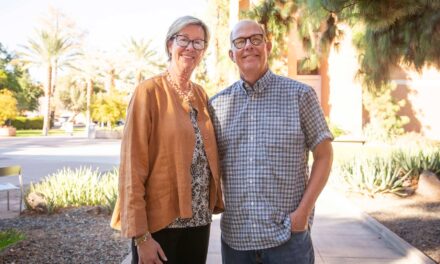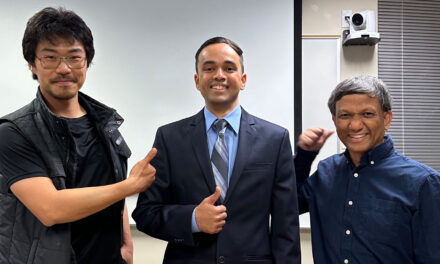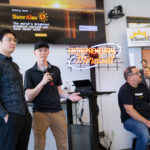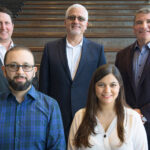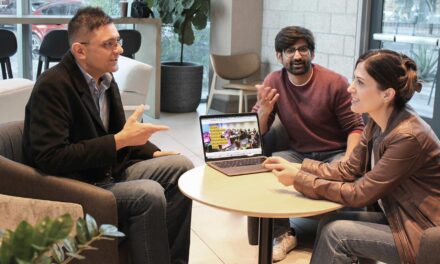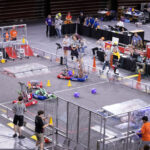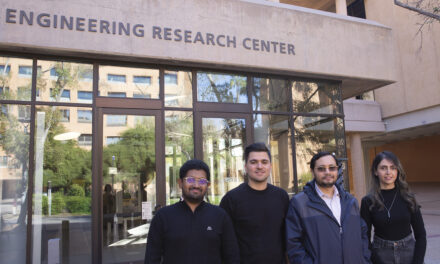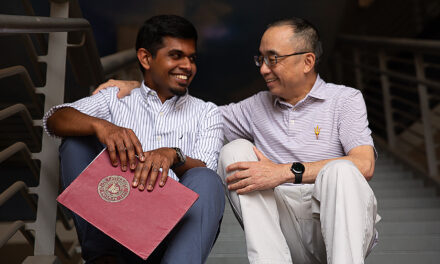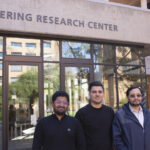
Kurt VanLehn: Intelligent tutoring research revolutionizes teaching
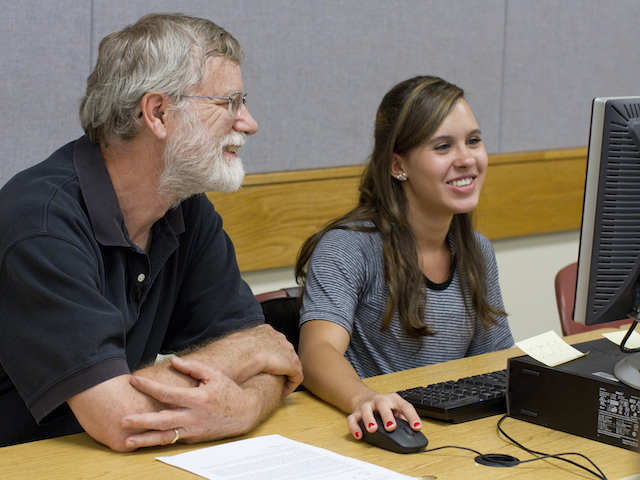
Kurt VanLehn, the Diane and Gary Tooker Chair for Effective Education in Science, Technology, Engineering and Math in the School of Computing, Informatics and Decision Systems Engineering, is researching how computer tutoring can be used in the classroom with multiple groups of students working with an instructor. Photographer: Jessica Hochreiter/ASU.
Kurt VanLehn sifts through layers of complexity looking for a profound answer: How can “intelligent tutors,” or computer-based learning programs, help us understand and utilize information more quickly.
It’s like peeking into the brain to see how information moves through our synapses and VanLehn thinks the picture is getting clearer.
VanLehn is the Diane and Gary Tooker Chair for Effective Education in Science, Technology, Engineering and Math in the School of Computing, Informatics and Decision Systems Engineering, one of the Ira A. Fulton Schools of Engineering at Arizona State University.
His path took him through Stanford, the Massachusetts Institute of Technology, the Palo Alto Research Center, Carnegie Mellon University and the University of Pittsburgh before landing at ASU, where he heads two multi-million dollar research projects looking at how people can best learn with help from computers.
“He’s world-renowned for building intelligent systems for deeper conceptual learning,” said Art Graesser, a professor of psychology and the Institute for Intelligent Systems at the University of Memphis, who is working with VanLehn on one of his latest research projects.
“He is a leader in helping people understand the mechanisms of thinking, reasoning and problem solving for the STEM fields (science, technology, engineering and math). He is the person who has crystallized this body of research.”
VanLehn’s life in academia might have been predicted, but the exact subject matter wasn’t set in stone.
Early Beginnings
He grew up in the small town of Yellow Springs, Ohio, where his father had graduated from Antioch College, an early bastion of student activism, anti-racism, and progressive thought where Martin Luther King Jr. gave the commencement address in 1965.
“It was a very liberal, socially conscious place, where students were leaders in the civil rights movement and in protesting the Vietnam War,” VanLehn said.
VanLehn remembers a civil rights protest in the town, when thousands of people and police faced off outside a barbershop where the barber had refused to cut the hair of a black man. VanLehn’s friend, Bo, climbed a lamppost to see what was happening and jumped down just as a car backfired. The crowd thought Bo had been shot.
VanLehn’s father was a chemical engineer, working in quality assurance for a company that made small rubber parts. VanLehn would visit the plant, where workers would be covered in carbon black from the operation. He became fascinated with the assembly machinery, conveyor belts and roller trays, and thought he might become a mechanical engineer.
The amalgam of social consciousness and mechanical curiosity would mix in VanLehn’s consciousness to produce a desire to build something to make the world a better place.
“My heroes were Einstein, Russell and Whitehead,” VanLehn said.
Albert Einstein, the German-born father of the theory of relativity, was a theoretical physicist and philosopher of science. Bertrand Russell and Alfred North Whitehead were British mathematicians, logicians and philosophers, who authored the “Principia Mathematica,” a three-volume work published in the early 1900s on the foundations of mathematics. It was an attempt to show that math flows from and can be proven by logic.
Their works would be building blocks for VanLehn’s explorations and fodder for all-night debates with his fellow college skeptics. How could someone start with the absolute fundamentals–as Einstein, Russell and Whitehead did–and yet still engineer a profound impact on the world?
Off to Campus
Although accepted at several eastern colleges, VanLehn’s visits left him disappointed.
His neighbor in Yellow Springs told VanLehn to check out Stanford, which no one in his high school had heard of. Stanford had the added attraction of a university forest and arboretum, which fascinated VanLehn, who helped maintain a small forest associated with his high school.
The “forest” at Stanford, however, was a disappointment; with VanLehn thinking the peeling bark of the eucalyptus meant they were dying.
“I visited a friend at the University of California, Santa Cruz, with all the redwood trees, and I thought, ‘Man, I really chose the wrong place.’ ”
But Stanford turned out to be the perfect place. Exciting classes—brilliant students—and weather that an Ohioan could only dream of.
At the same time, Vietnam protests were rocking the campus, shutting down classes and closing buildings. During VanLehn’s freshman year, draft numbers were issued, and classmates with low numbers just disappeared. Those who remained behind were both stunned and intensely aware of just how lucky they were, said VanLehn. When U.S. troops moved into Cambodia, riots enveloped the campus, and VanLehn had to bike through lines of San Jose Tac Squad members to get back to his dorm.
VanLehn considered being a professional musician, and played trombone in a rock band called Trust, which emulated Chicago and its larger-than-life brass section. He also helped maintain the band electronics and run the business side of the band, booking gigs at clubs and fraternity and dorm parties. But the band was too big to play most union venues so money was scarce.
“I got very good at painting houses and weeding,” he said.
To make ends meet, VanLehn started working at the Stanford Artificial Intelligence Laboratory, where the best minds in the world were developing the Stanford Artificial Intelligence Language, or SAIL.
“It was a really great time to be there,” VanLehn said. “We were changing the world, building good and useful things.”
VanLehn’s engineering side was happy, but his quest for fundamentals was on hold.
A Quest Continues
While at the Stanford lab, VanLehn met Terry Winograd, an MIT professor on sabbatical. Winograd was a pioneer in getting computers to understand typed English sentences, like his famous initial success, “Pick up the big, red block.” Winograd convinced VanLehn to go to MIT to work on a degree in artificial intelligence, with Winograd as his mentor. In 1974, after finishing his bachelor’s degree in mathematics, VanLehn packed his bags and moved, but Winograd stayed at Stanford.
“I was trained by Terry’s students,” said VanLehn, who worked at MIT’s Artificial Intelligence Laboratory. “But despite the great student mentors, it wasn’t working out, and I started looking for another career.”
VanLehn went to work with John Seely Brown, one of the pioneers of intelligent-tutoring systems and a scientist at Bolt, Beranek and Newman, a prestigious technology–consulting firm in Cambridge, Massachusetts.
After exploring technology for tutoring electronics, geometry and algebra, he, Brown and the rest of Brown’s group moved to the Xerox Corporation’s Palo Alto Research Center, or PARC, where Brown would eventually become the chief scientist.
At PARC, VanLehn, now remotely working on a doctorate from MIT, found himself at the intersection of the natural-language processing movement and efforts to harness computers to improve educational technology. It was like coming home.
“It had a strong social component, and was engaging and interesting,” VanLehn said. “Natural-language training was being applied to solve problems.”
Brown’s group had discovered “bugs,” or errors, not in the computers, but in how students were solving arithmetic problems.
“We wondered how these systematic human errors began,” VanLehn said. “We knew no one had taught the students the wrong way.”
VanLehn determined that, when learners got stuck at an impasse, they invented something to fill in the blank. The study of impasse-driven learning became the basis of VanLehn’s doctoral thesis.
He built a computer program that modeled the impasse-driven learning process and learned the bugs that Brown’s group had discovered. Eventually, he hit a wall with his research when he realized he could not observe the point where children acquired the “bugs,” and could only infer when it happened.
A New Stage
In 1985, VanLehn moved to Carnegie Mellon University as an assistant professor in the departments of psychology and computer science. In Pittsburgh, he met and eventually married Micki Chi, a young cognitive scientist who was already famous for her pioneering work on expert-novice differences and the expertise of children. At her urging, he wrapped up his work on arithmetic bugs, wrote a book, “Mind bugs: The origins of procedural misconceptions,” and looked for a new approach.
Using laboratory “toy” tasks, such as solving the Tower of Hanoi puzzle, he tried in observe learning as it occurred. “I had some great recordings of people learning. I could see their frowns and hear their pauses so I knew when something was happening,” he said, “but what they said made no sense, and I couldn’t pin down how they actually learned.”
Meanwhile, he moved to the University of Pittsburgh, where he worked in the Learning Research and Development Center.
“I was tired of toy tasks, and the Learning Research and Development Center was the perfect place to study learning of stuff that really mattered.”
He focused on physics, with instruction that a student could tackle in a few hours, while still being observed in the lab, the idea being that he could monitor the entire learning process. Using data from his wife’s studies of self-explanation, a phenomenon she discovered, he continued to build cognitive models and match them to human learners.
These were complex programs, and just getting them to learn at all was a feat. It was the early days of a field now called machine learning. Although his models matched human behavior, their complexity made VanLehn worry about their value as scientific models.
“I realized I had models I believed in, but that I would never get enough data to prove them,” VanLehn said. “I wondered what I could do with these models, how I could make them useful to society. Well, if you have something that can model a bridge, what do you do with it? Analyze bridges, to discover their strengths and weaknesses. So I set out to use my models of learning to assess the strengths and weakness of human learners, and guide them to learn better.”
So VanLehn shifted from cognitive modeling to developing tutoring systems, where he stayed ever since. In 2008, he came to ASU, which is becoming one the best in the world in learning research.
The idea of tutors has a long history, reaching back to royalty, who hired academics to teach their children one-on-one. That idea of one-on-one, human instruction is what most people think of when they use the word tutor, VanLehn said.
But once computers were invented, the idea of computer tutoring was born. Computer tutors were more economical, convenient and indefatigable. Exercises could be repeated until the student mastered the material. Computer tutors could also be considered “non-judgmental,” allowing the student to make mistakes in private and learn from them.
Most early computer-tutoring programs were simple question-and-answer programs that gave students a way to practice a skill until they learned it. As the technology matured, tutoring systems were developed for more complex tasks with more and more steps.
VanLehn’s Andes tutoring system coached college students as they solved difficult physics problems that took as much as an hour to solve. It gave students hints and feedback at every step along the way.
New Challenges
Now, VanLehn is working on a major leap: How can computer tutoring be used in the classroom with multiple groups of students working with an instructor.
His research is looking at how students’ physical devices, in this case, tablets, can be effectively networked with other students and the instructor, how students take in and manipulate the information, how the instructor can be prompted to provide helpful information based on the work students are doing in their group, and how complex projects or problems can be successfully completed.
He’s working on two multi-million research projects, the Formative Assessment Computer Technology, or FACT, a $7 million project funded by the Bill and Melinda Gates Foundation, and Dragoon, a $2 million STEM grant challenge funded by the National Science Foundation and the Office of Naval Research.
The FACT project uses step-based tutoring technology for group work on complex problems that take most of a class period to solve. For instance, one problem asks middle-school students to choose the best vendor for silkscreen T-shirts, based on different cost structures of the vendors.
Unlike fill-in-the-blank tutoring systems, FACT lets students write anything anywhere on the tablet using a scribe. First, the students work individually, then in pairs or small groups, then as a class. Students can see and modify each other’s work, and the teacher can monitor their progress, too. The program, reacting to their input, will suggest to the teacher specific hints and prompts that can be given to the students in order to push them to explore additional solutions.
“These are big mathematical explorations, not a worksheet with 20 problems,” VanLehn said. “The Common Core State Standards say students should know how to critique math arguments. They need to be thinking mathematically.”
The system is being tested in schools in Arizona, the San Francisco Bay area, Rhode Island, Michigan and Nottingham, England.
The Dragoon project teaches STEM concepts by allowing students to construct models with help from an intelligent-tutoring system, starting with well-defined models, for which they are told which data to use, and moving to less-defined models that require students to research and collect their own data, then use it to build a model. It is used to explore subjects like population growth, physiology, traffic flow or the stock market.
The Dragoon project has been used for several years in the ASU sustainability courses, and is being tested in high school classes. A prototype is under development for training Navy technicians, too.
Over the course of his teaching and research, VanLehn has seen a profound shift in how learning is viewed, from the traditional, looking at the process inside one person’s head, to the socio-cultural, which emphasizes how knowledge is created in a conversation between two people. He sees classrooms changing, and has flipped his own, having students cover lecture material on their own before class, and using the class time for engaged activity.
The idea of deeper conceptual learning, what it means and how it happens, is critical, Graesser said.
“It turns out the education system in the entire country is set up for shallow learning, memorization of words or facts, listening to a lecture or reading a book,” Graesser said. “For deep conceptual learning, you need to interact, to reason about complex problems. That’s what’s expected in the real world and what will be needed for major jobs of the future.
“Kurt is contributing to learning environments that promote this deeper kind of learning.”
Written by Judy Nichols
Media Contact
Sharon Keeler, sharon.keeler@asu.edu
(480) 965-4012
Ira A. Fulton Schools of Engineering


